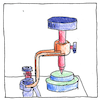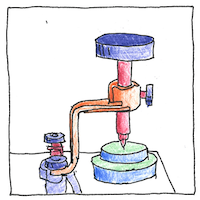Karl Ferdinand Braun,
Henry Harrison Chase Dunwoody,
Greenleaf Whittier Pickard
electromagnetism

|
Crystal diode
Karl Ferdinand Braun discovered unilateral conduction of crystals in 1874 and patented a cat’s-whisker crystal diode as a radio rectifier in 1899. Braun found that the point of a wire that lightly touches a semiconducting crystal creates a junction that permits electrons to flow from the wire to the crystal but not from the crystal to the wire. Around 1904, Henry Harrison Chase Dunwoody developed a cat’s-whisker detector using carborundum, and Greenleaf Whittier Pickard developed a cat’s-whisker detector using galena.
Cat’s-whisker detector
Different crystals made cat’s-whisker detectors—silicon, carborundum, galena, molybdenite, iron pyrite, iron disulfide. Some galena crystals made good detectors, and some didn’t no matter how you adjusted them. Generally, the magic wasn’t in the type of crystal; it was in finding the right pressure and point of contact. The fine point of the wire had to touch the crystal gently and some positions on the crystal wouldn’t work at all.
Crystal divination
The power of crystals to orient the mind precedes discovery of its electromagnetic effects. Listen carefully to the inside a seashell. It does indeed seem like the sound of the sea.



I made a radio in high school with a germanium crystal diode, and, using our garage door as an antenna, listened to the local AM station with an ear-bud.
See also in The book of science:
Readings in wikipedia: